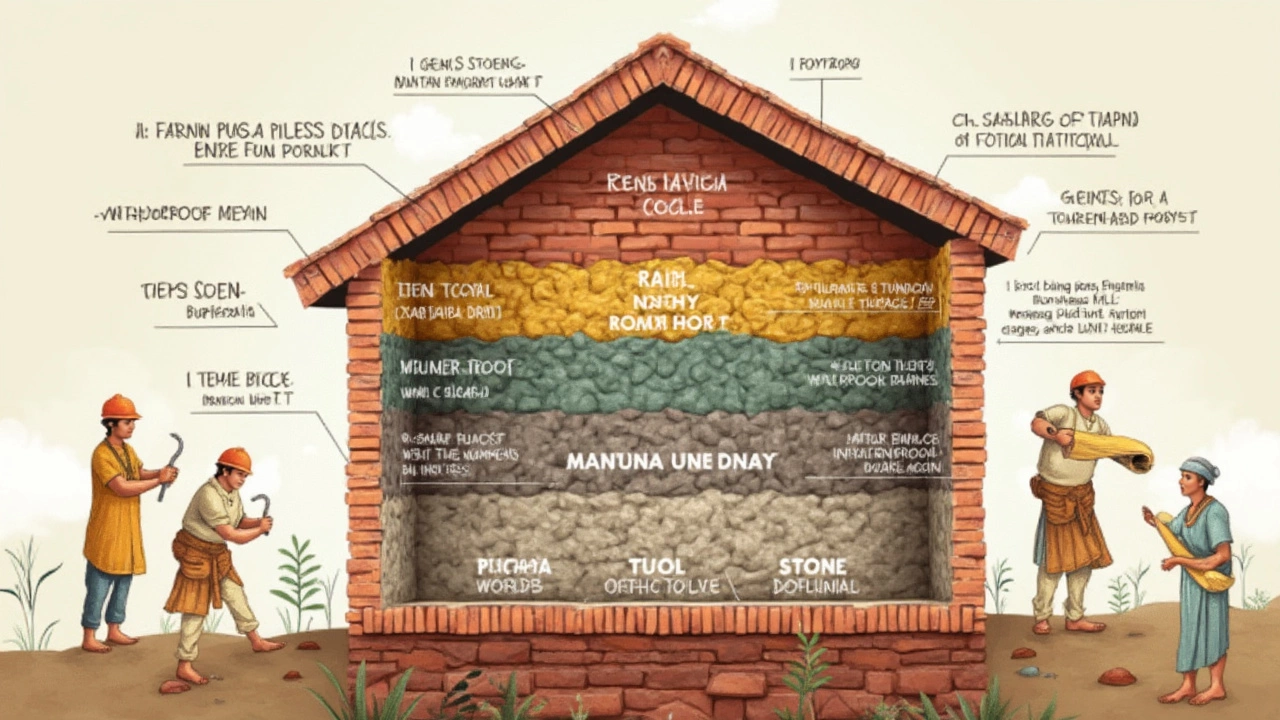Longest Lasting Construction Materials for House Building
If you’re building a house you actually want to last, thinking about style isn’t enough—you need to get into the nitty-gritty of how long that thing’s really going to stand. Forget fancy finishes for a second; construction material is where the real magic (or disaster) happens. Spend well here and your grandkids might get to see the place in one piece years later.
Here’s the cool part: some of the oldest homes on the planet are simple stone structures, still rock solid after hundreds, sometimes even thousands, of years. Nearby, you’ll also find modern homes that already have cracks and leaks after just a decade or two. What gives? The biggest difference is often in material choices, not location or even the size of the house. Ready to see which ones last the longest and why?
- Why Longevity Matters in House Construction
- Stone: Nature’s Endurance Test
- Concrete: The Modern Powerhouse
- Brick and Clay: Time-Tested Survivors
- Steel and Engineered Materials: Pros and Pitfalls
- Tips for Maximizing Your Build’s Lifespan
Why Longevity Matters in House Construction
Getting the right material isn’t just about bragging rights—it hits you in the wallet, your stress level, and the overall value of your home. If you don’t choose wisely, you could be stuck with constant repairs, higher bills, and even safety problems down the road.
If you look at insurance studies, homes built with the longest lasting material cost way less to maintain and insure over the years. According to recent NAHB (National Association of Home Builders) figures, a stone or concrete house can last 75–100 years, while wood-framed houses typically need heavy repairs at 30–50 years. That gap isn’t just about pride—it’s about real money and hassle.
Take a look at the numbers below. These aren’t random guesses—they’re the real average lifespans and costs of different types of house construction:
| Material | Average Lifespan (years) | Estimated Repair Cost Over 50 Years (USD) |
|---|---|---|
| Stone | 100+ | $12,000 |
| Concrete | 80–100 | $15,000 |
| Brick | 75–100 | $18,000 |
| Wood | 30–50 | $30,000 |
| Steel Frame | 60–80 | $22,000 |
Nobody wants to rebuild the family home every couple of decades, right? Longevity means less headache for you, a better chance your home’s value will grow, and more time doing literally anything else besides patching up walls or fighting leaks.
- It saves you big on maintenance and insurance.
- A long-lasting structure means safer living since it’s less likely to break down suddenly.
- Ever tried selling a house with a crumbling foundation? Lasting materials make resale so much easier.
So before you even think about tile colors or window styles, focus on the material your house is made of. That one decision can save you thousands and give you peace of mind for decades.
Stone: Nature’s Endurance Test
If you want a house that’s going to hold up for more generations than you can count, stone is the real deal. Probably the best example: buildings made from stone can last over a thousand years. Just think about the castles in Scotland or those ancient temples in Greece. They’re not still standing because people treated them gently—they were just built from seriously sturdy material.
What gives stone its edge is simple. When it’s stacked and set well, it’s nearly impossible for moisture, bugs, or even fire to take it down. Stone doesn’t rot, and termites aren’t going to eat granite or limestone, which is more than you can say for a lot of modern stuff. Plus, it doesn’t warp if temperatures swing from one extreme to another. That’s why some of the oldest bridges and walls across Europe and Asia are still in use.
Let’s put a few numbers side by side:
| Material | Average Lifespan (years) | Best Feature |
|---|---|---|
| Stone | 500+ | Doesn’t rot or burn |
| Concrete | 80-100 | Easy to form |
| Wood | 30-100 | Cheap and flexible |
Stone isn’t perfect, though. It’s heavy, so it costs more to move around, and building with it takes skilled masons who know what they’re doing. If you skip corners or use weak mortar, even the toughest rock can let you down. On the flip side, once that stone’s up, upkeep is practically nothing compared to other materials. Rain can’t wash it away. If you want a home that’s going to stick around longer than you need it, stone is hard to beat.
Quick tip: If you’re set on using stone for your house but don’t want the price to go through the roof, look into local materials. Transporting stone across long distances is one of the biggest costs, so source it close by if you can. And, don’t skip on a solid foundation—you don’t want all that weight shifting over the years.
That’s why when people talk about the longest lasting material for building, stone always gets a top spot on the list.
Concrete: The Modern Powerhouse
Drive through any major city, and you’ll see concrete everywhere—for good reason. When people talk about the longest lasting material for building houses in recent times, concrete is always in the conversation. There's a solid reason for that: properly made and cared for, concrete buildings can last 50 to 100 years or even more.
The secret is in the chemistry. Concrete is mostly cement, sand, gravel, and water. Once it sets, it doesn’t rot, rust, or burn. That’s why you see concrete houses standing strong even after hurricanes or fires. A great example: the Pantheon in Rome is a 2,000-year-old concrete building and still holding up its huge dome.
Modern concrete homes often use a style called reinforced concrete, where steel rods (rebar) are placed inside before the concrete dries. This stuff handles earthquakes and heavy loads way better than just plain concrete, making it a top pick for safety and durability.
| Type | Average Lifespan | Best For |
|---|---|---|
| Standard Concrete | 50–100 years | Walls, floors, driveways |
| Reinforced Concrete | 75–150 years | Foundations, large structures |
| Ultra-high Performance Concrete | 100+ years | Bridges, extreme climates |
It’s not all sunshine, though. Bad construction, lots of freeze-thaw cycles, or salty air from the coast can damage concrete way faster. A few things can help keep a concrete home in shape:
- Seal exterior surfaces to block out water and protect against cracks.
- Deal with drainage issues fast—standing water is concrete’s enemy.
- Watch for rust on any exposed steel and fix it early.
If you care about energy use, concrete walls are great for insulation. They keep homes cooler in summer and warmer in winter because the material absorbs and slowly releases heat. Plus they’re nearly fireproof, which insurance companies really like.
Costs run higher at first, but fewer repairs and less maintenance make up for it in the long haul. For most folks looking for a home that’ll last almost a lifetime—with the least drama—concrete is a smart move.

Brick and Clay: Time-Tested Survivors
When people talk about houses that outlast just about anything, brick and clay almost always come up. They’re basically the original “set it and forget it” materials. Ancient brick structures in places like Jericho and the ruins of Mesopotamia are still around—some over 7,000 years old! That says a lot about their tough nature.
Why do brick and clay last so long? First up, they’re fired at really high temperatures. This process bakes out the water, hardens the material, and makes the bricks super resistant to rain, fire, insects, and even extreme temperature swings. Plus, clay bricks are made from natural stuff: clay, sand, and water.
Today, modern brick houses can last at least 100 years with barely any fuss, if you lay them right and keep the mortar joints in check. Brick homes are also famous for easy maintenance—wash them down once in a while, keep plants from growing in the cracks, and you’re good for decades.
Check out these simple but useful facts:
| Feature | Brick/Clay |
|---|---|
| Typical Lifespan | 100-500+ years |
| Maintenance | Very low |
| Fire Resistance | Excellent |
| Natural Insulation | Above average |
| Common Repairs | Mortar repointing |
Here’s what helps brick and clay really shine in house construction:
- They don’t warp, rot, or get eaten by bugs like wood does.
- Bricks handle wind, rain, and sun without much fading or breaking down.
- They help keep homes cooler in summer and warmer in winter, saving a bit on energy bills.
- They’re fireproof, which is a huge plus if you live in wildfire zones or just want some peace of mind.
If you’re thinking about building or fixing up a brick house, don’t skip regular checks on the mortar—the stuff that holds the bricks together. Once every decade or even more is usually enough. And if you spot any cracks or missing pieces, patching things up early stops moisture from getting in and causing trouble down the line.
Steel and Engineered Materials: Pros and Pitfalls
Steel houses have gained a solid reputation over the last few decades, and for some good reasons. Structurally, steel is tough—resistant to termites, mold, and fire. No wonder you see those steel skeletons holding up skyscrapers and stadiums. When it comes to home building, though, steel’s pros and cons get pretty interesting.
Let’s cut to the chase with the big advantages. Steel frames don’t warp, swell, or split like wood. Engineered steel panels are built in factories, so quality control is tight. You can even get pre-fab kits, where the pieces arrive ready to bolt together—kind of like a life-size Lego set.
- Longest lasting material in modern construction if protected from rust
- Fireproof, keeping your home safer in wildfire-prone areas
- Pests and insects can’t eat it
- Less shrinkage and movement over time compared to wood
But it’s not all sunshine. The biggest enemy of steel is water. If moisture gets to unprotected steel, corrosion and rust set in fast. The trick is proper coating and careful construction. Steel frames also need special insulation because steel transfers heat and cold more easily—meaning your home could feel like a freezer in winter or an oven in summer without good insulation.
And then there’s cost and skill. Steel is usually pricier than wood, not just for the materials but for the labor too. Fewer contractors are trained in steel frame home building, so finding the right builder can be a hurdle. On the bright side, engineered materials like cross-laminated timber (CLT) and structural insulated panels (SIPs) are catching on, giving options that blend the longevity of steel with the warmth of wood, or better energy efficiency.
| Material | Average Lifespan | Notable Strength | Main Weakness |
|---|---|---|---|
| Galvanized Steel | 75+ years (with maintenance) | Fire, pests, mold | Corrosion if exposed to water |
| CLT (Engineered Timber) | 60–80 years | Dimensional stability, eco-friendly | Sensitive to prolonged moisture |
| SIPs (Insulated Panels) | 50–70 years | Energy savings, fast install | Vulnerable at seams if not sealed well |
If your budget allows, and you live in an area where termites and wildfires are a real threat, steel could be a top choice. Just don’t skip on proper coatings, good insulation, and professional installation. Looking for a blend? Modern engineered materials like CLT and SIPs are worth checking out, especially if you’re aiming for efficient, sturdy, and faster assembly.
Tips for Maximizing Your Build’s Lifespan
If you want your house to last as long as those ancient stone buildings, you’ve got to think ahead right from day one. Even with the longest lasting material, it’s not just about what you use—it’s how you use it and how you take care of it later on.
Here are some solid moves to make your house go the distance:
- Pick quality materials: Cheap concrete or low-grade steel can turn into a nightmare fast. Go for proven brands and stuff that’s rated for your area’s climate.
- Don’t skip on waterproofing: Water can wreck concrete, rust steel, and ruin timber. Good membranes, drainage, and flashing are boring, but they matter more than fancy paint.
- Insulate like you mean it: Proper insulation protects against temp swings that crack, warp, or rot building parts, whether you’re using brick, stone, or wood.
- Ventilation is key: Good airflow keeps mold, rot, and condensation away. You want vents in your attic, crawlspace, and bathroom. Don’t cheap out on fans.
- Handle maintenance early: Small cracks, peeling caulk, and clogged gutters turn into major repairs if you ignore them. Walk around your house twice a year and fix stuff when you spot it.
- Foundation first: If your foundation shifts or settles, nothing on top will stay right. Test your soil, get proper drainage, and don’t let trees or roots near it.
Real talk: Even concrete can crumble if you ignore it. The oldest Roman buildings used ancient concrete mixed with volcanic ash, and studies show that time, water, and freeze-thaw cycles are the main reasons modern stuff fails faster.
Here’s a table that shows how long some key construction materials usually last if looked after:
| Material | Expected Lifespan (Years) | Key Maintenance |
|---|---|---|
| Natural Stone | 1000+ | Repoint mortar, prevent vines |
| Brick | 100 - 500 | Repoint mortar, repair cracks |
| Concrete | 70 - 100 (modern) | Seal surfaces, patch cracks |
| Steel | 50 - 100 | Paint/coating, rust control |
| Timber (properly treated) | 50 - 100 | Pest/damp control, sealants |
If you nail both your material choices and these practical care habits, your house really can hold up for generations. Save this list—most people forget these basics until they’re dealing with leaks or crumbling walls, but a little time now saves a ton of money (and headaches) later.







Comments